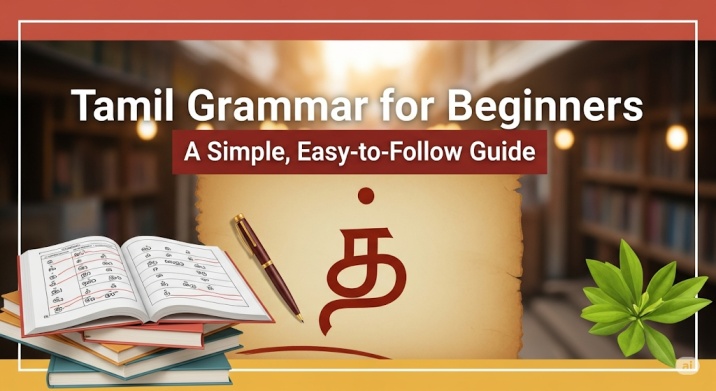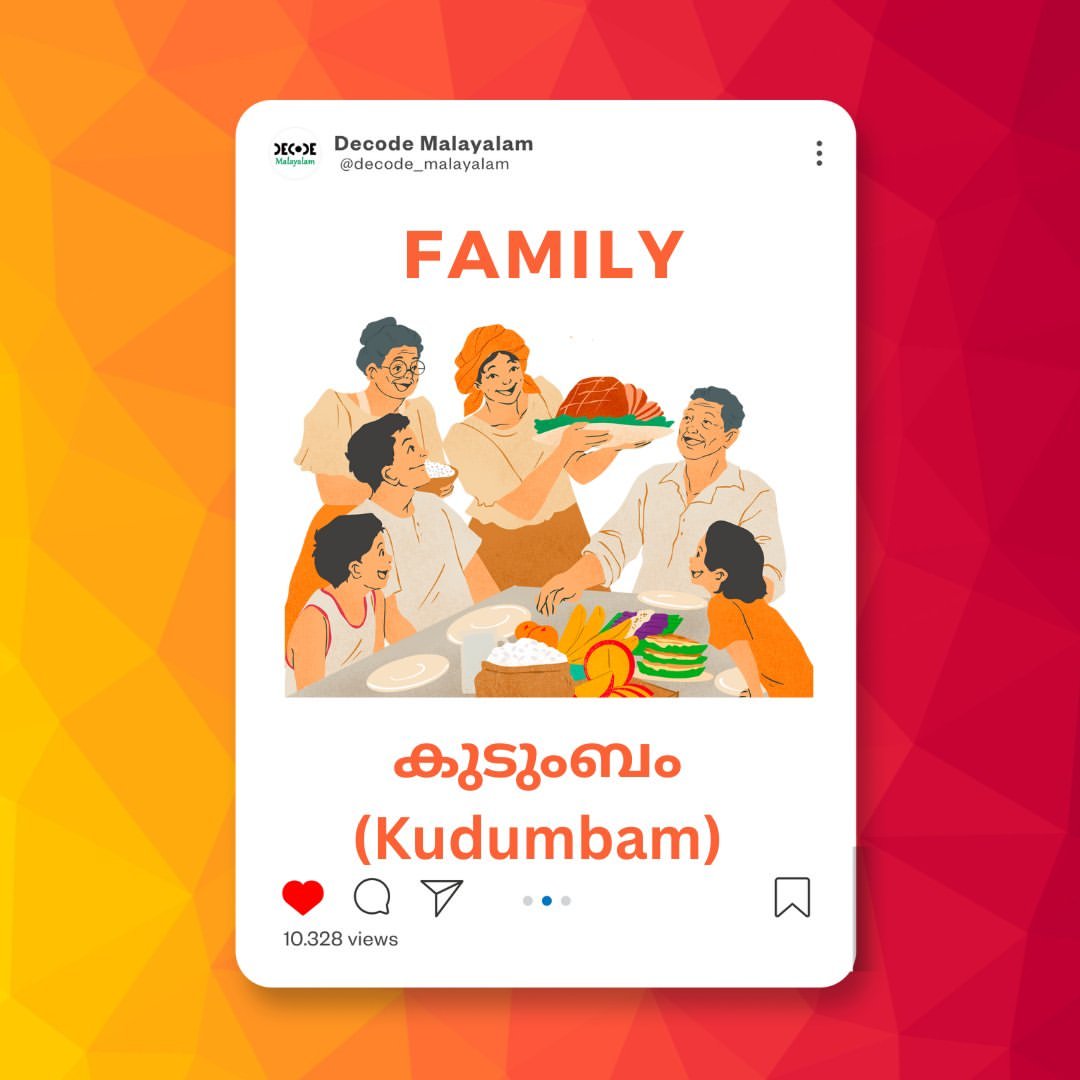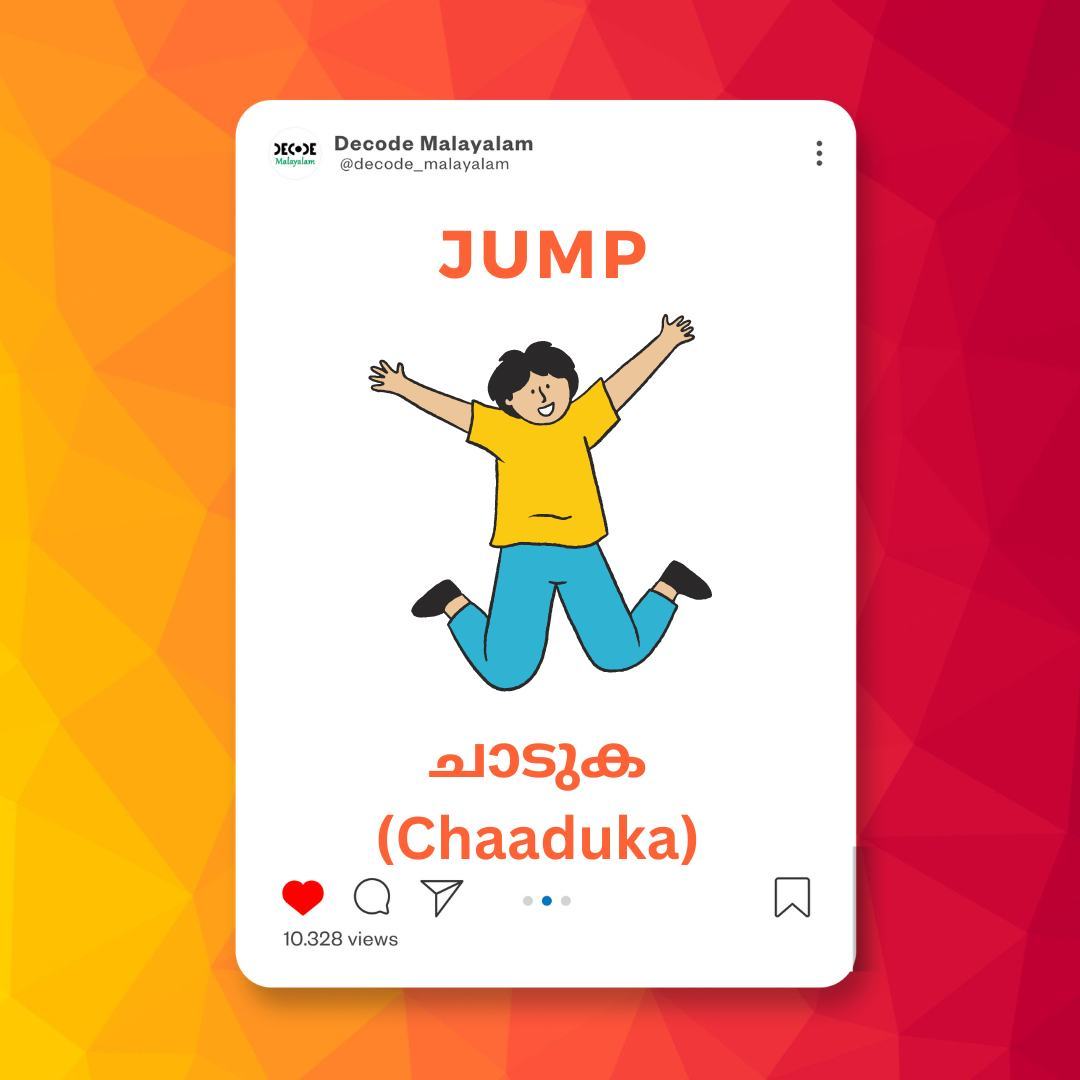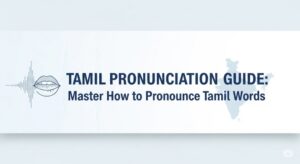Tamil Grammar for Beginners: A Simple, Easy-to-Follow Guide
Unlocking the secrets of Tamil sentence structure, verbs, and more with simple rules.

Introduction: Demystifying Tamil Grammar Basics
Welcome to the world of Tamil, one of the oldest and most beautiful languages on Earth. If you’ve ever felt intimidated by its script or the way sentences are formed, don’t worry! This guide is designed to simplify **Tamil grammar for beginners**. We’ll break down the core concepts into manageable, easy-to-digest sections. By the end of this article, you’ll have a solid foundation to start building your own sentences and understand conversations better.
Unlike English, which follows a Subject-Verb-Object (SVO) structure, Tamil uses a Subject-Object-Verb (SOV) structure. This is one of the most fundamental **Tamil grammar basics** you need to understand. Let’s dive in!
Chapter 1: The Building Blocks – Sentence Structure (SOV)
The SOV structure is the backbone of most Tamil sentences. It means the subject comes first, followed by the object, and the verb always comes last. This might feel unusual at first, but with a few examples, it will become second nature.
English (SVO): I (Subject) eat (Verb) an apple (Object).
Tamil (SOV): நான் (Subject) ஒரு ஆப்பிள் (Object) சாப்பிடுகிறேன் (Verb).
(Naan oru aappil saapidugiraen)
As you can see, the verb ‘saapidugiraen’ (eat) is placed at the very end. This structure is consistent across most sentences in Tamil, making it a reliable rule to remember.
Understanding Subject, Object, and Verb
- Subject: The person or thing performing the action. (E.g., I, he, she, the cat, the student).
- Object: The person or thing receiving the action. (E.g., a book, an apple, water).
- Verb: The action word. (E.g., eat, read, go, sleep).

Chapter 2: Nouns and Pronouns
Nouns and pronouns are crucial for any language. In Tamil, they are straightforward and essential for forming even the simplest of sentences.
Personal Pronouns (Subject)
Here are the most common pronouns in Tamil:
| English | Tamil | Pronunciation |
|---|---|---|
| I | நான் | Naan |
| You (singular, informal) | நீ | Nee |
| You (singular, formal) | நீங்கள் | Neengal |
| He | அவன் / அவர் | Avan (informal) / Avar (formal) |
| She | அவள் / அவர் | Aval (informal) / Avar (formal) |
| We | நாம் / நாங்கள் | Naam / Naangal |
| They | அவர்கள் | Avargal |
Pro-Tip: Tamil has different words for ‘you,’ ‘he,’ and ‘she’ depending on the level of respect you want to show. Use `நீங்கள்` (Neengal) for a respectful “you,” and `அவர்` (Avar) for a respectful “he” or “she.” This is a key part of Tamil social etiquette.
Possessive Pronouns
To indicate possession, Tamil adds a suffix to the noun or pronoun. For example:
- My book: `என் புத்தகம்` (En puththagam)
- Your house: `உன் வீடு` (Un veedu)
- Our car: `நமது கார்` (Namathu car)
Chapter 3: The Heart of the Sentence – Verbs
Verbs are the action words, and they change based on tense (past, present, future) and the subject. Don’t be overwhelmed; the patterns are quite logical.
Understanding Verb Roots and Suffixes
Every Tamil verb has a root. Tense and person are indicated by adding suffixes to this root. Let’s take the verb root `படி` (Padi), which means “to read.”
Present Tense
To form the present tense, you add the suffix `+கிறேன்` (+kiraen) for the first person singular (I).
Root: படி (Padi)
I read: நான் படிக்கிறேன் (Naan padikkiraen)
Past Tense
To form the past tense, you typically add `+த்தேன்` (+ththaen).
I read (yesterday): நான் படித்தேன் (Naan padiththaen)
Future Tense
For the future tense, you add `+ப்பேன்` (+ppaen).
I will read: நான் படிப்பேன் (Naan padippaen)
While these are general rules, some verbs are irregular. However, knowing these basic patterns is a powerful start to learning **Tamil grammar basics**.

Chapter 4: Tamil Case System – The “Glue” of Sentences
Tamil uses a case system, where suffixes are added to nouns to show their function in a sentence (e.g., as a direct object, an instrument, or a location). These suffixes are the “glue” that holds sentences together, and they are crucial for a proper **Tamil grammar for beginners** understanding.
Common Case Endings:
- Accusative (`-ஐ`): Indicates the direct object.
Book: புத்தகம் (Puththagam)
I read the book: நான் புத்தகத்தை படித்தேன். (Naan puththagaththai padiththaen.)
- Locative (`-இல்`): Indicates location.
House: வீடு (Veedu)
I am in the house: நான் வீட்டில் இருக்கிறேன். (Naan veettil irukkiraen.)
- Dative (`-க்கு`): Indicates “to” or “for”.
To Chennai: சென்னைக்கு (Chennaikku)
I am going to Chennai: நான் சென்னைக்கு போகிறேன். (Naan Chennaikku pogiraen.)

Chapter 5: Putting It All Together – Simple Sentences
Let’s combine everything we’ve learned to form some simple sentences. Remember the SOV structure and the use of suffixes.
- He drinks water.
- அவன் (Avan) – He (Subject)
- தண்ணீர் (Thannir) – Water (Object)
- குடிக்கிறான் (Kudikkiraan) – Drinks (Verb)
- Sentence: அவன் தண்ணீர் குடிக்கிறான். (Avan thanni kudikkiraan.)
- She bought a new dress.
- அவள் (Aval) – She (Subject)
- ஒரு புதிய ஆடை (Oru puthiya aadai) – A new dress (Object)
- வாங்கினாள் (Vaanginaal) – Bought (Verb)
- Sentence: அவள் ஒரு புதிய ஆடை வாங்கினாள். (Aval oru puthiya aadai vaanginaal.)
By breaking down these examples, you can see how each component fits together, just like building blocks. Practice with different nouns and verbs to get a feel for the structure.
Chapter 6: Final Words and Pro-Tips for Learning
Learning a new language’s grammar can be challenging, but it’s also incredibly rewarding. Here are some final tips to help you on your journey:
- Focus on Verb Endings: These are the most complex part of Tamil grammar, but they are also the most important. Once you get a handle on them, you can express yourself in different tenses with ease.
- Listen and Repeat: The best way to internalize grammar rules is to hear them in action. Listen to Tamil songs, watch movies, or use language learning apps.
- Don’t Be Afraid of Mistakes: Everyone makes mistakes. The goal is communication, not perfection. Native speakers will appreciate your effort.
- Practice with Simple Sentences: Start small. Try to describe your day using the SOV structure and the nouns and verbs you’ve learned. “நான் புத்தகம் படித்தேன்,” “நான் காபி குடித்தேன்.” (I read a book, I drank coffee).
Ready to take your Tamil learning to the next level?
Explore more articles on our website for detailed lessons on Tamil vocabulary, pronunciation, and conversational phrases. Your journey to fluency starts here!













